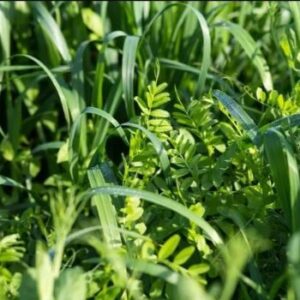When looking for ways to improve soil fertility, gardeners often turn to cover crops. This planting strategy is often utilized on large agricultural farms, but can be used by home gardeners to help improve soil fertility and structure and increase crop yields in their gardens.
What are Cover Crops?
Cover crops are plants that are grown for the purpose of covering soil rather than for food production and harvest. These plants include grasses, legumes and other herbaceous plants or “forbs.” They are most commonly sown as seeds in the late Summer and Fall and grown through the off-season in between other desirable crops. While growing, they are referred to as a living or green mulch, and “green manure” when they are incorporated back into the soil before they go to seed while still green.
What is the point of a Cover Crop?
Generally, cover crops help suppress weeds and prevent soil erosion. After a crop is harvested and a fruit-producing plant is removed, bare soil is exposed. When soils are exposed for prolonged periods of time, such as through the Winter, they can dry out and lose water quickly through evaporation, runoff and eventually, erosion. Cover crops are grown to cover and anchor soils so that water penetrates the soil and stays there.
What are the benefits of Cover Crops?
There are many added benefits to growing cover crops, too. They increase soil fertility, quality and structure. Many of these plants’ roots grow deeply, pulling up nutrients from the soil that otherwise would be leached out. Deep roots also aerate the soil, breaking up compaction in heavy clay. When they are “turned” back into the soil in the Spring, the plants decompose and make these nutrients available for the new season’s crops. This reduces the need for fertilizing and tilling, which can be costly and detrimental to overall soil health when done in excess.
Do Cover Crops attract insects?
Cover crops are also useful in attracting pollinators and beneficial insects to fight off garden pests. Many cover crops flower in early Spring, providing an early food source for various pollinators such as honeybees, bumblebees and our own native bees. They also provide habitat and food for other beneficial insects, such as predatory wasps, beetles (lady bugs) and parasitoids that prey on aphids, mites and other pests. Having these beneficial insects is a great way to control pest populations organically, without using harsh pesticides and chemicals.
What are examples of Cover Crops?
There is a wide range of plants that are used as cover crops, but a few that are commonly used in home vegetable gardens. The three common categories are grasses, legumes and forbs. Each group provides unique benefits.
- Cereals/Grains/Grasses: Plants such as wheat, rye and oats provide abundant biomass that suppresses weeds and adds nutrients back into the soil when they decompose.
- Legumes: Plants in the Legume Family (Fabaceae) are fast-growing and Nitrogen-fixing, meaning that they draw up Nitrogen, an essential nutrient for plant growth, in a complex relationship with soil bacteria. Nitrogen-fixing legumes include peas, soybeans, clovers, and vetches.
- Other forbs: Broadleaf herbaceous plants that break up soils with fibrous roots, suppress weeds, and attract pollinators. They include buckwheat, sunflower, safflower, and Brassicas like kale, mustard, radishes and turnips.
Should you plant more than one Cover Crop?
Growing a variety of cover crops is highly advantageous for home gardeners. You can plant just one cover crop, but sowing a variety of different plants will help achieve multiple benefits. A combination of grasses, legumes and other forbs are recommended to increase biodiversity and reap the rewards of various plants. Nurseries and garden centers may sell seeds for a single crop, such as clover or oats, but you’ll often find custom mixes of different plants. These mixes are usually chosen to have a balanced composition.

Learn about Glover’s Custom Cover Crop for Utah here.
When should you plant Cover Crops?
Gardeners can plant cover crops at different times, but the most common time to plant cover crops is at the end of Summer and into early Fall. This allows plants enough time to grow foliage and roots before the ground begins to freeze. This means that your cover crop will grow through the Winter and early Spring, when the majority of gardens are empty of vegetables and other edible crops. Some crops will die over the winter, but still provide biomass and nutrients come springtime.
How do you plant Cover Crops?
Cover crops are actually sown, meaning they are cast over the soil as seeds and raked in. The seeds then germinate and start to grow.
To sow cover crops, follow these steps:
- Prepare your planting bed/box: Remove spent plants and any debris. Rake soil evenly.
- Prepare your seed: Shake any seed mix gently to evenly mix the seeds.
- Sow your seeds: Gently scatter seeds over the planting area, making sure that they are evenly distributed and not clumped together. You can broadcast them with your hands or use a seeder.
- Rake them in: Gently rake over the area to incorporate the seeds to about a ¼” depth.
- Water them in: Water the seeds thoroughly with a fine mist sprayer. Keep seeds evenly moist during the germination process.
Tip: You can even grow cover crops in the same bed at the same time as cool-season crops such as kale or carrots.
Turning: Incorporating Nutrients into your Soil
Nutrients from cover crops only become available to new plants after the crop’s foliage begins to decompose. The way to get this process started is by incorporating them back into the soil, or “turning” them. This can happen a few different ways, but generally, you want to cut the plants down to the roots and either place them back on top of the soil or dig them back into the top layer of soil. Cutting your plants down to the roots is also called “termination.”
The best time to terminate your cover crops is when they begin to flower and before they go to seed. With seeds sown in August/September, this is usually early Spring. The biomass acts as a green manure that decomposes and adds nutrients back to the soil. You then want to give the plants enough time to begin to decompose, at least 2-3 weeks before sowing any new garden crops.
Are Cover Crops easy to grow?
Yes, they are very easy to grow! The are plants that don’t need any extra fertilizer or excessive amounts of water.
Key Terms:
Herbaceous: A plant whose stem does not become woody and will die back to its roots in the winter.
Biomass: A measurement of the amount of vegetative growth (foliage, stems, roots) of plants
Green Manure: A plant that is grown to specifically be incorporated into the soil while it is still green.
Turning: Incorporating plant material, compost or other organic material into the soil by tilling or other methods.
Termination: Stopping the growth of a crop.

